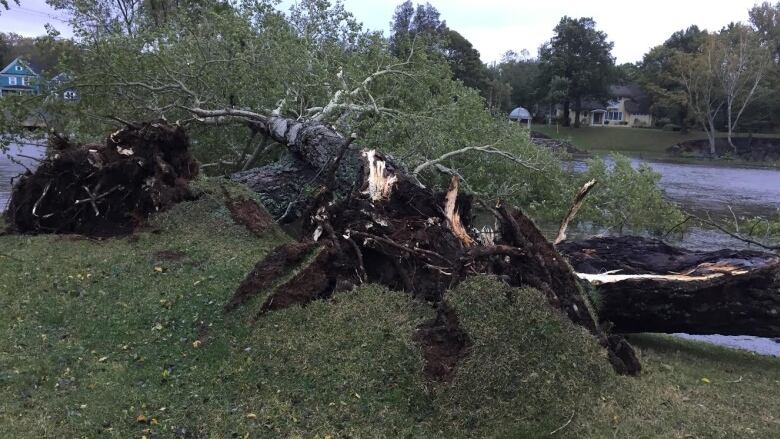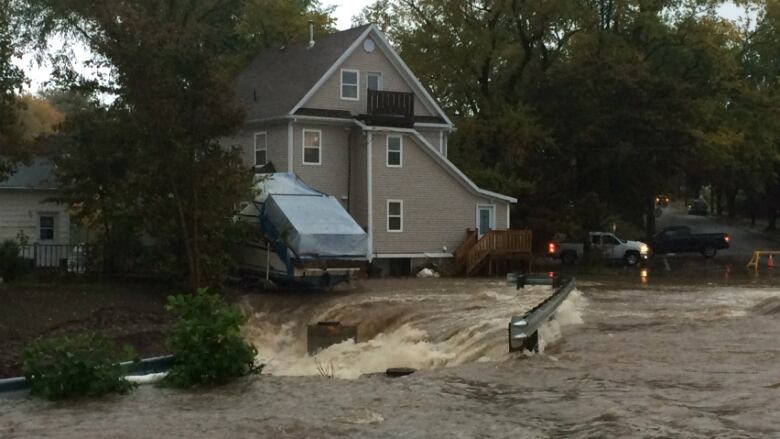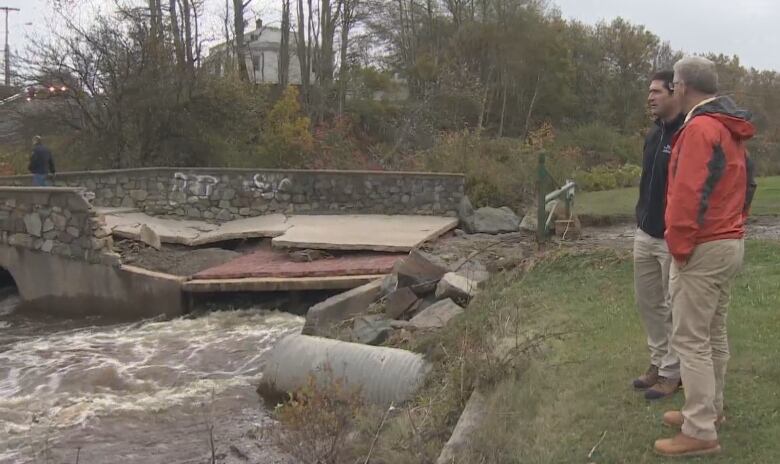Cape Breton region seeks disaster assistance after widespread flooding
Comfort stations and overnight shelters set up in Sydney, North Sydney and Reserve Mines

The widespread damage caused by flooding in the Cape Breton Regional Municipality has prompted the mayor to seek disaster assistance, a day after record-breaking rainfall in the area.
Cecil Clarke said he hasspoken to MPs Mark Eyking and Rodger Cuzner, as well as provincial Transportation Minister Geoff MacLellan, about getting disaster relief.
"We're trying to get an assessment of that right now," said Clarke. "We are into millions upon millions of negative impact."
People forced out of their homes can stop by comfort stations set up in the Reserve Mines Fire Department (203 Main Street)or the North Sydney Firefighters Club (14 Pierce Street). Officials have set up an overnight shelter and comfort station at the Grand Lake Road Volunteer Fire Department (850 Grand Lake Road in Sydney).
The Canadian Red Cross is offering help at those locations, where people can drop by to charge up their phones, or get some food and drink.
Centre 200 will open at 9 a.m. Wednesday to replace the Grand Lake Road comfort station. Centre 200 has showers people can use. Officials will decide tomorrow if Centre 200 will also act as an overnight shelter.
If you need help getting to a comfort station, call 902-563-5151.
Clarke said it's too soon to tell exactly how much the cleanup is going to cost, and health and safety is the number one priority.
MacLellan said it's too early to discuss any provincial funding becausethe focus remains on clearing the roads and making sure people can access medical facilities.
Double-storm-whammy hits Cape Breton
The Sydney area got about 225millimetres of rain on Monday, according to unofficial numbers from Environment Canada.The weather system is a result of the remnants of Hurricane Matthew meeting up with a system off the coast of the Carolinas.
"It's unprecedented for this area. It was scary yesterday," saidMacLellan.
"[We've had] two devastating weather events back on back that have stretched the resources of the region and municipality," said Clarke.
"The most important thing is that people are safe, we haven't suffered a loss of life."

Water beginning to recede
Homes, schools, roads and bridges have been flooded and power has been knocked out to thousands of homes after strong winds toppled trees. Clarke said the municipality needs generators and sump pumps to help with the cleanup.
However, the engineering and public works director for CBRM,Wayne MacDonald, said water is starting to recede.
He said 90 per cent of water infrastructure has backup power. There are no boil water orders in place and normalwater pressure has been restored.
Half of Glace Bay homes damaged
Clarke said public works officials believe Glace Bay was hit particularly hard, with water or sewer damage inmore than50 per cent of homes.
On Tuesday morning, families stopped by the Cameron Bowl field to survey the water surging throughthe area where kids play. MacLellansaid the field, a community staple for generations,isthe "epicentre" of the storm damage.
He doesn't expect there will any ball played there next summer.
"It's sad to see it pulled to pieces," MacLellansaid."The clean-up effort alone is significant but to rebuild it, that's a different level. This is a tough day for sure."

Flooding can lead to fires
Roy Boutilier, a volunteer firefighter in Reserve Mines, said he's spent the last day or so using the fire department's pumps to get water out of people's homes.
"We did have a home that had water going into the home through the window. Water had built up in the yard so quickly that it actually entered through the window."

Boutilier said the woman who lived there was upset and didn't realize staying in the home might be dangerous.
He said people should evacuate if they don't feel safe and kill the power if water levels start rising. All too often people don't think to leave unless their home is on fire, Boutilier said.
"Once it reaches the plugs, your home is in jeopardy of causing a fire," he said.
Roads a no-go
The Cape Breton Regional Police said people are still driving through flooded areas despite barricades and warnings telling them not to.
"Manhole covers have lifted right out of the manhole, creating obviously a hole that sometimes can be covered with water and drivers not be able to see that," said Christina Lamey a spokeswoman for the municipality.
"It is dangerous to drive through standing water on the road."
Oil and sewage in floodwaters
The Department of Transportation has also noted that the shoulders of many roads outside the urban areas have been washed away and pose a hazard to anyone driving on them.
- Here are theroads affected by flooding and high winds in Cape Breton
- Cape Breton residents warned to avoid floodwaters due to contamination
Lamey said one of the best things you can do is "look out for your neighbours."
"Many, many, if not most people are dealing with this in some way today. Everything you can do to help your neighbourhood is probably the best thing," she said.
"Stay close to home, preferably, rather than travelling somewhere at a distance."
With files from Information Morning, Peggy MacDonald, Gary Mansfield












_(720p).jpg)


 OFFICIAL HD MUSIC VIDEO.jpg)
.jpg)



























































































